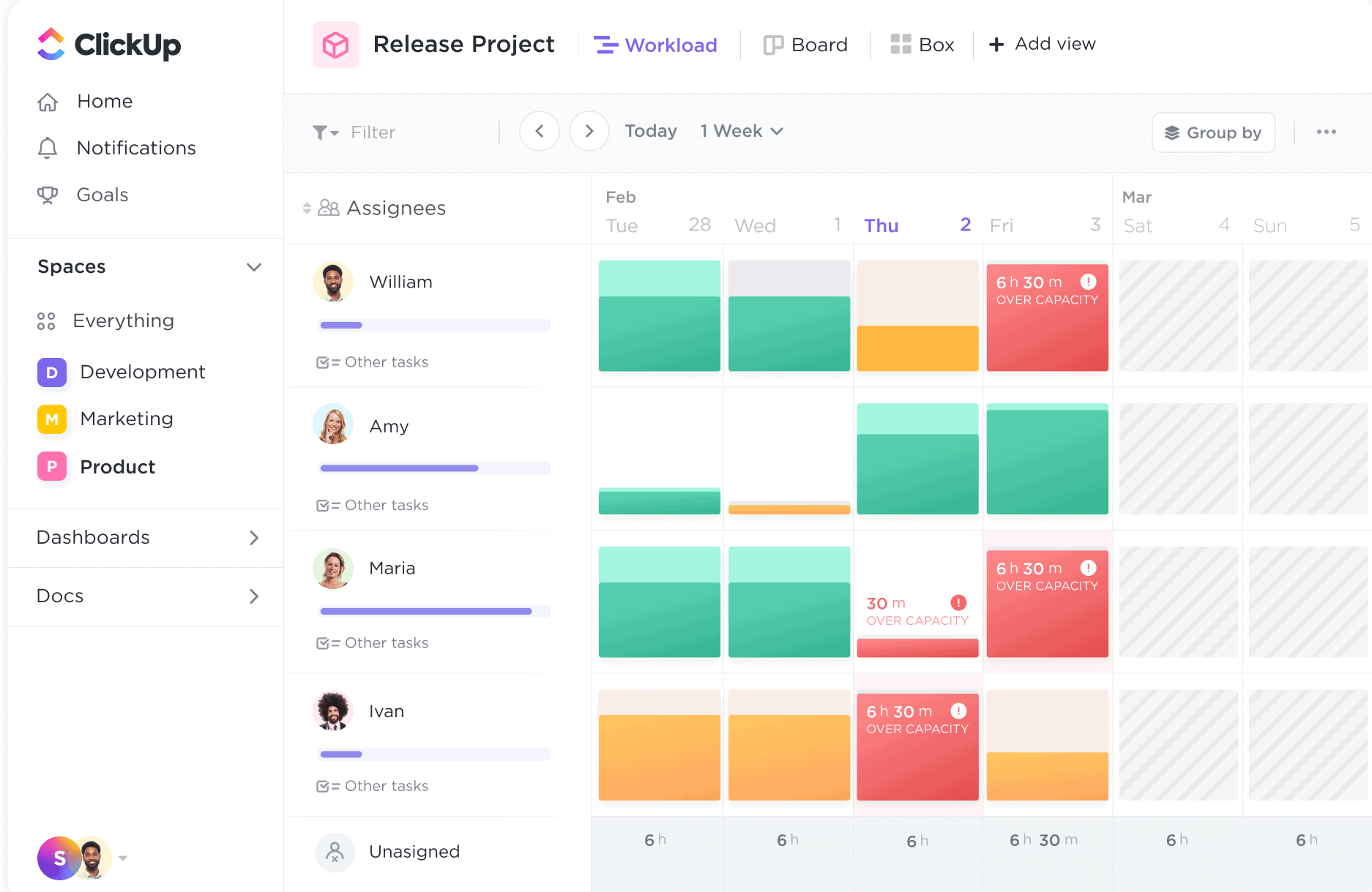ما الذي يتطلبه إكمال المشروع بنجاح؟ الناس والوقت والمال؟ نعم، ولكن هناك المزيد. يتطلب إكمال المشروع بنجاح جدولة الموارد المناسبة للمهام الصحيحة في الوقت الصحيح وبترتيب منطقي.
لذا، فلا عجب أن تخسر الشركات ملايين الدولارات في التكاليف الحقيقية وتكاليف الفرصة البديلة من التأخير أو تجاوز الميزانية.
كمدير مشروع، فإن الجدولة الفعالة للموارد هي المفتاح لضمان النجاح.
ما هي جدولة الموارد؟
تعد جدولة الموارد جزءًا مهمًا من إدارة المشروع، حيث يتم تعيين مهام محددة لأعضاء الفريق المتاحين لإكمالها خلال وقت محدد مسبقًا. هناك طريقتان أساسيتان لجدولة الموارد: مقيدة بالوقت أو مقيدة بالموارد.
جدولة الموارد المقيدة بوقت محدد
إذا كان هناك موعد نهائي محدد للمشروع، فستقوم بتعيين الموارد لإكمال العمل ضمن هذا الجدول الزمني. هناك موعد نهائي ثابت في هذه الحالة، لكن الموارد مرنة. عادةً ما تستخدم مؤسسات الخدمات المهنية أو الوكالات التي لديها موارد إضافية في انتظار المشاريع جدولة الموارد المقيدة بالوقت.
وينطبق ذلك أيضًا على المشاريع التي لها تاريخ إطلاق محدد. على سبيل المثال، إذا كنت تتطلع إلى إطلاق مشروع في عيد الميلاد، فأنت مقيد بالوقت حتى 25 ديسمبر (أو قبل ذلك).
الجدولة المقيدة بالموارد
من ناحية أخرى، إذا كان لديك عدد محدود من الموارد، فسوف تخطط للمشروع وفقًا لتوافر الموارد والقدرة الاستيعابية.
تتطلب هذه الطريقة لإدارة الموارد مرونة في الجداول الزمنية. تستخدم الجدولة المقيدة بالموارد عادةً من قبل شركات المنتجات أو الفرق الداخلية، حيث تقوم بتعيين أعضاء فريق إضافيين أو متعاقدين. على سبيل المثال، عندما تضيف ClickUp ميزات الذكاء الاصطناعي إلى منصتنا نقوم بجدولة المشروع مع قيود الموارد في الاعتبار.
في كلتا الحالتين، يخضع جدول الموارد بشكل أساسي للموارد والوقت. لنأخذ مثال فريق إنتاج المحتوى . يضم محللي تحسين محركات البحث والكتاب والمحررين والمصممين والناشرين. هنا، يقوم كل شخص بمهمته بعد الانتهاء من المهمة السابقة. لذلك ، تحتاج إلى جدولة الموارد بالتتابع كعدو سريع كل أسبوعين.
- بحث وموجز تحسين محركات البحث من اليوم 1-3
- الكتابة من اليوم 4-9
- التحرير من اليوم 10-12
- التصميم من اليوم 13-15

حتى هذا الجدول الزمني البسيط للموارد يمثل تحديات. كما ترى من الرسم البياني أعلاه، يحتاج محلل تحسين محركات البحث أو المحرر إلى ثلاثة أيام لإكمال مهمته، بينما يحتاج الكاتب إلى ستة أيام لإكمال مهمته.
لذا، إذا كان لدى هذا الفريق مورد واحد لكل مهارة، فإن الجميع باستثناء الكاتب سيكونون غير مستغلين بشكل كافٍ. هذه هي بالضبط المشكلة التي تسعى الجدولة الفعالة للموارد إلى حلها.
لماذا تعتبر جدولة الموارد مهمة في إدارة المشاريع؟

تصل تكاليف العمالة إلى "70% من إجمالي نفقات تشغيل المؤسسة" يقترح بحث معهد إدارة رأس المال البشري (HCMI). وهذا يعني أنه على الرغم من أن الموظفين هم أكبر أصولك، إلا أنهم أيضًا أكبر نفقاتك. لذلك، تحتاج إلى الاستفادة منهم على النحو الأمثل والفعال.
الاستفادة المثلى من الموارد
عرض عبء العمل في clickup
ستلاحظ أننا لم نقل "تعظيم موارد الأشخاص" لأن أفضل استخدام لمهارة الشخص لا يجب أن يساوي دائمًا 100٪ من وقته. في الواقع، " بحث جارتنر أن الفرق ذات الاستخدام الأقل يمكن أن تقلل من الوقت الذي يستغرقه تقديم قيمة الأعمال بنسبة 30% أو أكثر."
تمكّن جدولة الموارد مديري المشاريع من استخدام وقت أعضاء فريقهم بفعالية. فهي تمكنهم من تحقيق أفضل استخدام للأشخاص والمهارات المتاحة لتحقيق أقصى قدر من النتائج.
التسليم في الوقت المحدد وفي حدود الميزانية
استفد من جدولة الموارد لضمان إكمال المشروع في الوقت المحدد والميزانية المخصصة.
يتيح لك ذلك تصور المسار المستقبلي للمشروع وإجراء ما يلزم من خطط الطوارئ في وقت مبكر. عند وقوع حدث غير متوقع، قم بتعديلها أو تحويلها حسب الحاجة.
تقديم خدمات عالية الجودة
جدولة المشروع أكثر من مجرد تقويم الموارد . وهو عبارة عن تصور شفاف لكيفية تنفيذ المشروع. سيحتوي على مهام المشروع والمسؤوليات والتبعيات وعمليات التسليم والتسليم والتعاون ودورات التغذية الراجعة وما إلى ذلك.
مع هذه الرؤية الشاملة، يفهم كل عضو في الفريق دوره في دورة حياة المشروع. وبهذه الطريقة، سوف يتعاونون مع أقرانهم بشكل أكثر فعالية، ويتلقون تسليمات شاملة ويمررون تعليمات واضحة. وسيقدمون معًا خدمات تفي بالمعايير المتوقعة.
توفير التكاليف
من السهل تحديد الثغرات في خطتك عندما تقوم بجدولة مواردك مسبقاً. وهذا يمنح مديري المشاريع الوقت والفرصة للتوظيف مقدمًا أو تبديل فرقهم لسد الثغرات.
بدون جدول زمني للموارد، ستظهر الثغرات بشكل متكرر أثناء المشروع، مما يجعل الجميع يتدافعون لإيجاد حلول ويؤدي إلى نفقات غير ضرورية. تتسبب الفجوات في الجدول الزمني للمشروع أيضًا في حدوث مشكلات في إدارة الموارد حول مشاركة الموظفين وأدائهم والاحتفاظ بهم.
مراجعات واستعراضات قوية
المراجعة الجيدة هي المراجعة التي تقيس فيها النتائج مقابل الخطة، ويكون جدول الموارد بمثابة الخطة. تساعدك المراجعات على فهم ما إذا كانت هناك أي تأخيرات أو تجاوزات في الميزانية أو مشاكل في التعاون أو غيرها من التحديات الشخصية. قم بهيكلة خطط التحسين المستمر للمشاريع المستقبلية بناءً على ذلك.
فوائد جدولة الموارد
الهدف من أي مشروع هو توليد أو زيادة الإيرادات. تضمن جدولة الموارد حصولك على النتائج التي تطلبها.
لأعضاء الفريق
مع وجود جدول موارد واضح ومرئي وشفاف، يعرف كل عضو من أعضاء الفريق بالضبط ما يحتاجون إلى القيام به، وبأي معايير، وفي أي وقت. لذلك، لديهم:
- الوضوح بشأن دورهم للقيام بأفضل ما لديهم من عمل، مع تحمل المسؤولية عن نتائجهم
- مسار للإنجاز للتخطيط للإجازات والاستراحات والإجازات والإجازات وغيرها من الأحداث الحياتية الكبيرة
- الإحساس بالهدف لربط مهامهم بأهداف العمل، مما يعزز الالتزام
- المشاركة في مكان العمل من أجل تعاون أفضل
- رؤية الأداء لتحقيقأهدافهم خلال المشروع وفهم كيف سيتم تقييم نجاحهم
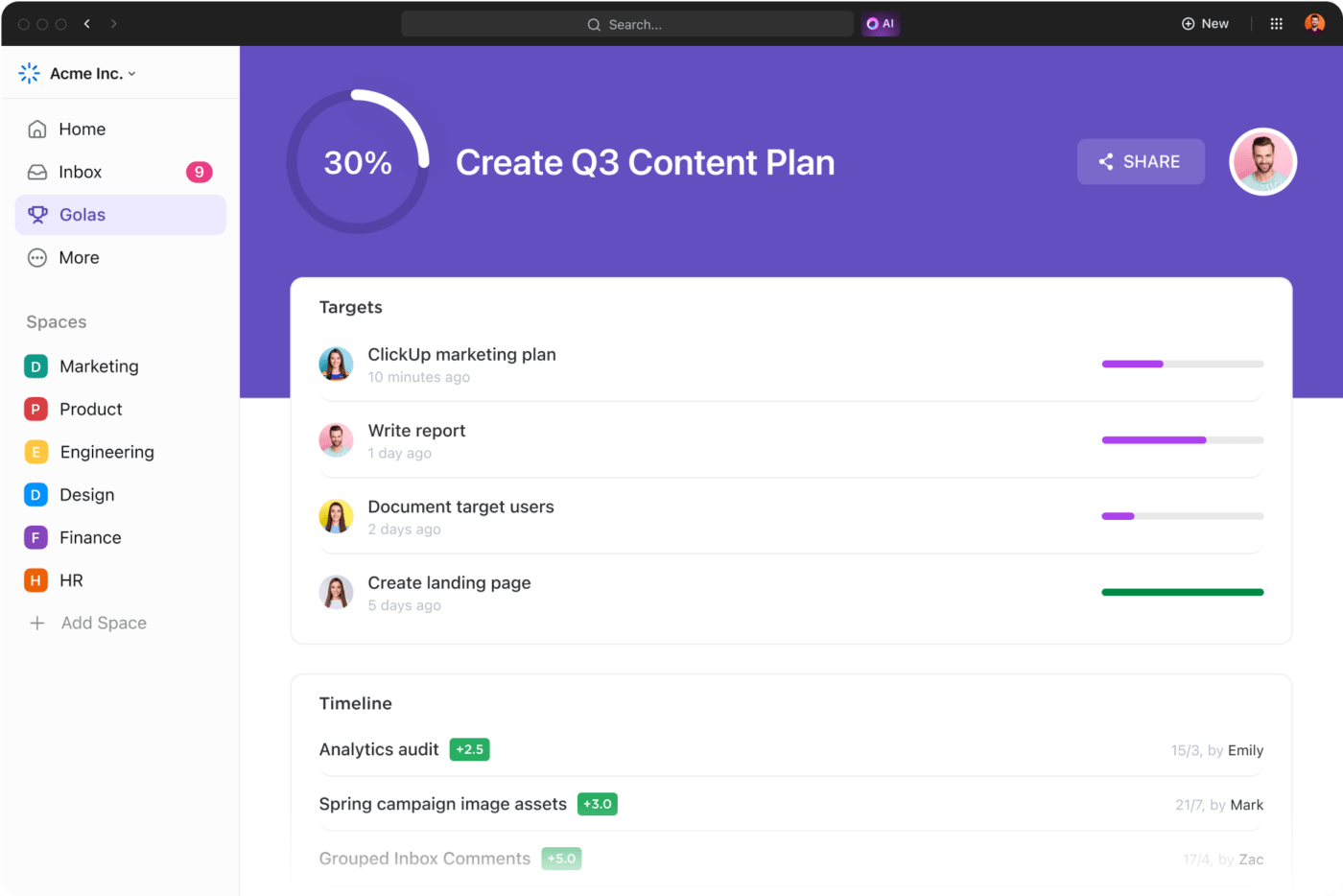
وضع أهداف قابلة للقياس للمهام والمشروعات مع التقدم التلقائي لتحقيق الأهداف بفعالية أكبر مع جداول زمنية محددة وأهداف قابلة للقياس الكمي
لمديري المشاريع
سوف يدير القادة المشاريع والمهام والفرق والنتائج بفعالية من خلال تخصيص الموارد لتوفير ما يلي
- نظرة واضحة على من يقوم بماذا، وتحسين الاستخدام ومشاركة الموظفين
- نظرة عامة على الثغرات أو الأعباء الزائدة لمعالجتها وإبقاء المشروع على المسار الصحيح
- القدرة على التنبؤ بالتأخيرات أو التجاوزات في الميزانية لمنع المشاكل والاستعداد للمشاكل التي لا مفر منها
- القدرة على التكيف مع التغيرات مع تطور متطلبات السوق أو احتياجات العملاء أو الهياكل التنظيمية
- حرية توصيل حالة المشروع بدقة وبانتظام إلى القيادة
للمنظمة
تساعد الجدولة الفعالة للموارد المنظمة على الاستفادة من الفريق على النحو الأمثل.
- توظيف الأشخاص المناسبين في الوقت المناسب
- فرض السعر المناسب على العميل بناءً على تقدير شبه دقيق للجهد والوقت
- تحديد الثغرات في المهارات أو القدرات لتخطيط استراتيجية التعلم والتطوير
- توقع الطلب على الموارد بدقة
- منع زحف النطاق
كيفية إنشاء جدول الموارد؟
1. تحديد نطاق المشروع ومتطلبات الموارد
قبل البدء في عملية جدولة الموارد، ابدأ بتحديد نطاق المشروع والموارد التي تحتاجها لإكماله. أثناء القيام بذلك، ضع في اعتبارك ما يلي.
الوقت المتاح لك: فكر فيما وراء عدد أيام العمل. ضع في اعتبارك أيضًا ما إذا كانت هناك أيام إجازة أخرى قد ينضم إليها الناس في عطلة نهاية أسبوع طويلة أو حدث داخلي كبير قد يشارك فيه فريقك.
المهارات المطلوبة: حدد جميع المهارات التي تحتاجها لإكمال المشروع، بما في ذلك المهارات التقنية والتشغيلية والإدارية.
الموارد المطلوبة: قد يمتلك الفرد الواحد أكثر من مهارة واحدة. يمكن أن يمتلك عدة أفراد نفس المهارة. قم بإنشاء المجموعة المثلى من أعضاء الفريق لتكوين المهارات التي تحتاجها.
هيكل تقسيم العمل (WBS): قم بتقسيم المشروع إلى مكونات صغيرة وتراتبية ويمكن التحكم فيها، أي المهام.
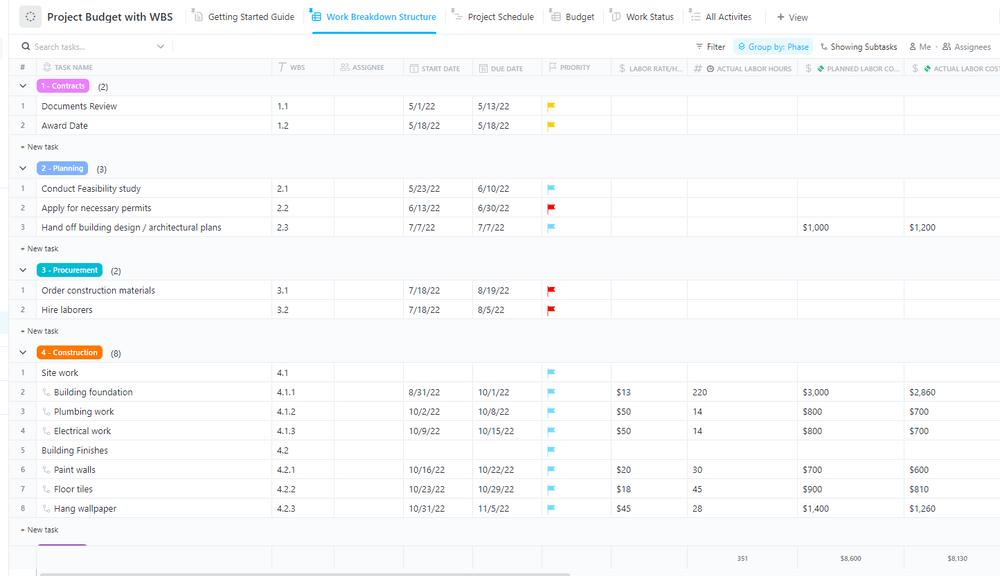
الترابطات: حدّد الترتيب الذي يجب على فرقك إكمال المهام وكيفية تأثير أحدها على أنشطة المنبع أو المصب.
القيود: هل هي ضيقة الجدول الزمني للمشروع ? هل عدد الأشخاص أقل مما تعتقد أنك بحاجة إليه؟ هل الميزانية محدودة؟ هل يعمل فريقك عبر مناطق زمنية مختلفة لا تتداخل فيما بينها؟
حدد كل عائق من المحتمل أن تواجهه. قم أيضًا بتقييم الطلب على الموارد داخل مؤسستك من أجل مشاركة أفضل للمهارات.
منجزات المشروع ومقاييس النجاح: اكتب ما تتوقع من كل عضو في الفريق أن يقدمه وكيف ستقيس أداءه. سيضمن ذلك أن يكون الجميع على نفس الصفحة وأن يقدموا أداءً متناغمًا.
2. اختر أداة لإدارة الموارد
لطالما استخدمت المؤسسات الجداول وجداول البيانات لجدولة الموارد. وهي تعمل مع المهام البسيطة والمتسلسلة مثل تلك الموضحة أعلاه. ومع ذلك، عندما تصبح الفرق أكبر، وتصبح المهام معقدة، وتزداد التبعيات، فإنك تحتاج إلى برنامج جدولة الموارد المصمم لتلبية متطلباتك.
كل ميزة تحتاجها لجدولة الموارد هي جزء من تطبيق ClickUp لإدارة المشاريع.
- مهام المشروع
- يمكن للمستخدمين تخصيص مهام محددة لـ
- القدرة على رؤية أعباء العمل وتكييفها مع الاحتياجات الحالية
- التبعيات بين المهام والمشاريع
- متتبع الوقت والجداول الزمنية لإدارة أبسط
- قائمة، وكانبان، وتقويم، وطرق عرض مخطط جانت
- لوحات المعلومات لمراجعات الأداء السريعة
- التوثيق والتعليقات ولوحات المعلومات للتعاون
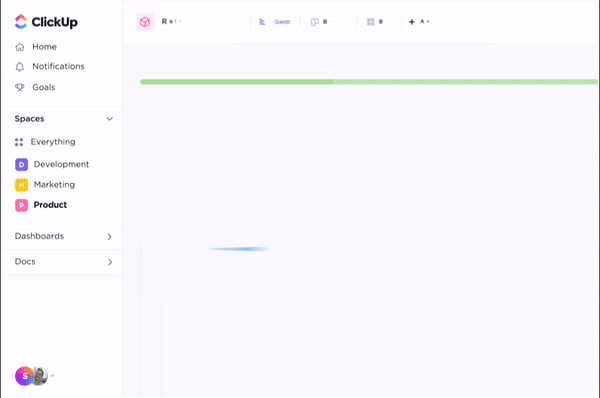
قم بتحويل أهم مهامك إلى معالم رئيسية لإنشاء تمثيل مرئي للتقدم المحرز في مشاريعك
يحتوي ClickUp أيضًا على إمكانات السحب والإفلات بسهولة، وواجهة سهلة الاستخدام، وإشعارات، وسير عمل قابل للتخصيص لجعل جدولة مشروعك بسيطة وفعالة.
3. إنشاء المهام
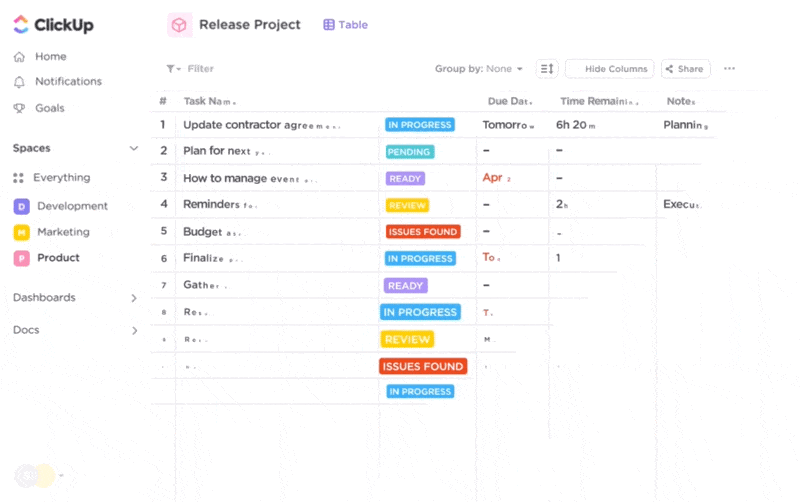
إدارة المهام والمشاريع، والتعاون بكفاءة مع فريقك باستخدام ClickUp
بمجرد اختيار أداة إدارة الموارد الخاصة بك، قم بإعداد المشروع كمجموعة من المشاريع الفرعية والمهام والمهام الفرعية وقوائم المراجعة. باستخدام ClickUp، لديك مرونة كاملة مع إدارة المهام .
التخصيص: إنشاء البنية المطلوبة باستخدام الأتمتة ونقاط السرعة وبيانات الحقول المخصصة والمزيد.
التسلسل الهرمي: أنشئ مهام فرعية متداخلة وأعد ترتيبها أو تحريرها بسهولة. قم أيضًا بتعيين التبعيات أثناء قيامك بذلك.
التجميع: تنظيم المهام حسب الفئات، وإنشاء حالات مخصصة، وتعيين الأولويات، وإضافة علامات. اربط المهام والمستندات والتكاملات لتمكين الوصول المعرفي لكل أعضاء الفريق.
المهام المتكررة: قم بتعيين اجتماعات أسبوعية أو تذكيرات يومية كمهام متكررة لإضافتها إلى قائمتك تلقائياً.
القوالب: استخدم قوالب المهام لإنشاء سير عمل للمهام المتكررة. على سبيل المثال، يمكنك إعداد قالب علاقة مرشح لإعادة استخدامه كلما تقدم شخص ما بطلب توظيف جديد.
المعالم: حدد الأهداف التي تدل على اكتمال المراحل الأساسية في مشروعك. خذ الوقت الكافي للاحتفال بها أيضًا.
4. تعيين موارد المشروع

تأكد من رؤية تعليقاتك من خلال تعيين تعليقات للمستخدمين مباشرةً في المهام، واحصل على عرض سريع للتعليقات المعينة في قائمة التحقق
تعيين أفراد لكل مهمة/مهمة فرعية. باستخدام أداة إدارة الموارد في ClickUp، يمكنك تعيين عدة أفراد لمهمة ما. يمكنك أيضًا إضافة مشاهدين، والذين سيحصلون على إشعارات عند وجود تحديث أو تغيير في الحالة.
استخدم طريقة عرض ClickUp Box View لمعرفة مدى انشغال أعضاء الفريق أو توفرهم. استخدم طريقة عرض عبء العمل لقياس ما إذا كان كل عضو من أعضاء الفريق مشغولاً أو أقل من طاقته. قم بتشغيل تتبع الوقت والتقديرات للبقاء على اطلاع على التقدم المحرز.
5. تقييم الجدوى
بمجرد الانتهاء من الإعداد، حان الوقت للتحقق والتأكد من أن كل شيء على ما يرام. استخدم 15+ مشاهدة يعرض ClickUp القيام بذلك.
عرض التقويم: استخدم عرض التقويم (الأيام أو الأسابيع أو الأشهر) لـ إدارة الوقت ومعرفة ما إذا كانت المعالم الرئيسية تتماشى مع المواعيد النهائية للمشروع.
طريقة عرض جانت: استخدم عرض جانت للتأكد من أن المهام التي تعمل بالتوازي لا تعتمد على بعضها البعض. انقلها لضمان سلاسة تسليم المهام من مرحلة إلى أخرى، مما يعزز إدارة الموارد. في ClickUp، يمكنك أيضًا تحديد المسار الحرج ووقت التأخير لإعادة جدولة بعض الأعمال دون التأثير على المواعيد النهائية الأكبر.
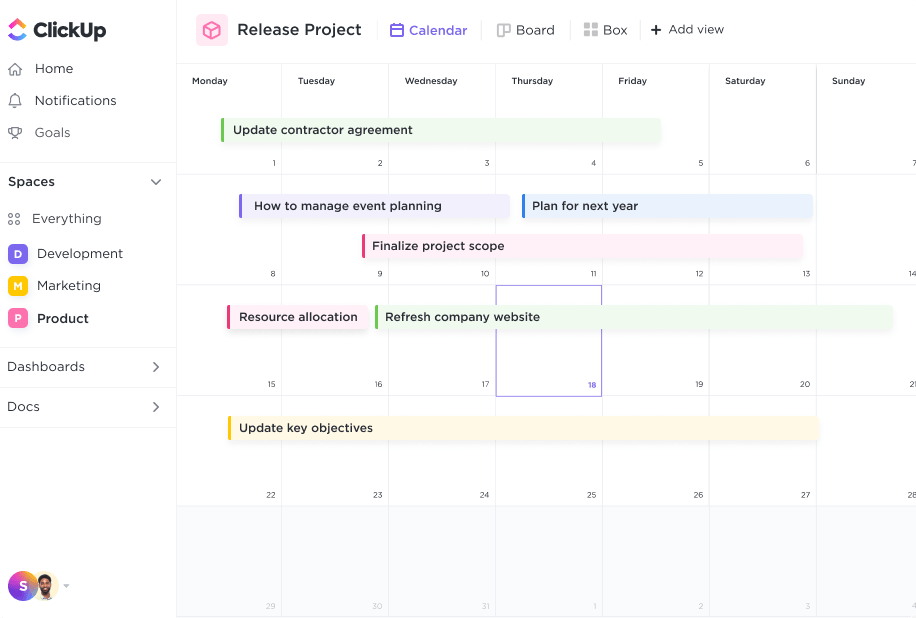
نظّم المشاريع، وخطط الجداول الزمنية، وتصور عمل فريقك على تقويم مرن يبقي الجميع على نفس الصفحة
عرض الجدول الزمني: تصوّر خارطة الطريق والمهام المنجزة والأحداث المستقبلية على خط زمني الجدول الزمني للمشروع لتمشيط الحالات الشاذة
6. قم بإعداد فريقك للنجاح

استخدم ClickUp's Docs لإنشاء مستندات جميلة ومواقع ويكي والمزيد من أجل تنفيذ الأفكار بسلاسة مع فريقك
اجمع كل أصول المشروع الضرورية في مكان واحد. يمكنك استخدام مستندات ClickUp لتوثيق المشاريع. إذا كانت لديك أصول في أدوات أخرى مثل Figma أو جداول بيانات Google، فقم بتضمينها في مساحة عمل ClickUp أيضًا. استخدم ClickUp Whiteboard لتبادل الأفكار تمكين التعليقات للفريق للتحدث مع بعضهم البعض أو تحويل التعليقات إلى مهام بسرعة!
7. مراقبة وتحسين
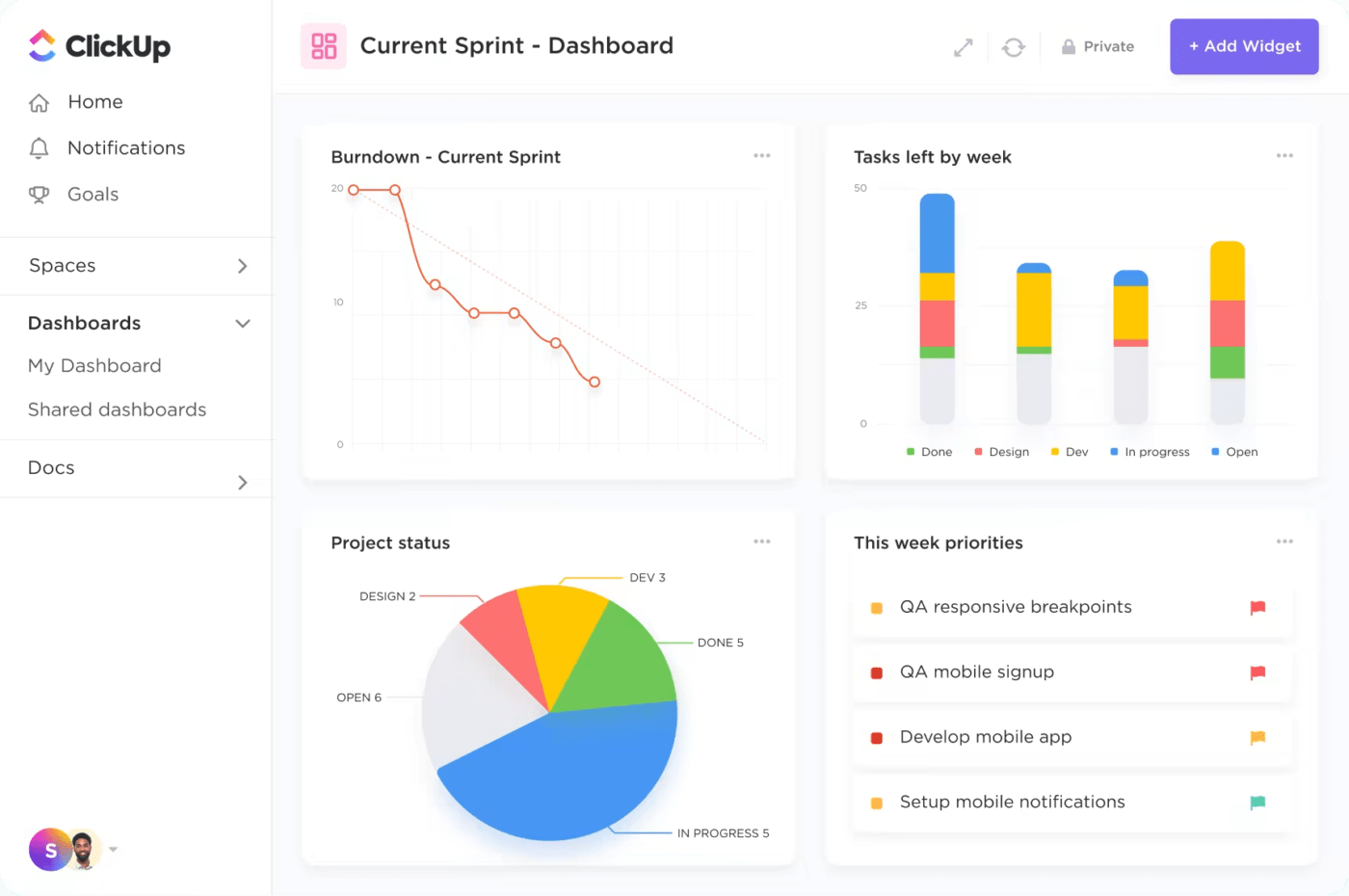
تتبع ومراقبة المهام والموارد وتقدم المشروع في عرض لوحة معلومات ClickUp Dashboard
لا تنتهي جدولة الموارد عند بدء المشروع. فبينما تكمل الفرق مهامها كل يوم، يجب على مديري المشاريع مراقبة التقدم المحرز وإجراء التعديلات، إذا لزم الأمر. استخدم ClickUp Dashboards لهذا
أنشئ لوحة معلومات مخصصة مع مؤشرات المشروع الحيوية بالنسبة لك. أضف أدوات لأعضاء الفريق والمسارات الحرجة وسباقات السرعة والحالات والجوانب الأخرى في مكان واحد.
إذا كنت تبحث عن مساحة عمل فارغة، فاستخدم ClickUp قالب تخطيط الموارد . قم بتخصيصه حسب احتياجاتك دون عناء. إليك المزيد قوالب تخطيط الموارد في Excel وجداول بيانات Google لمساعدتك في اتخاذ قرارك.
6 استراتيجيات لجدولة الموارد الفعالة ## 6 استراتيجيات لجدولة الموارد الفعالة
بعد الاطلاع على التفاصيل المطلوبة لجدولة الموارد الفعالة، إليك بعض الاستراتيجيات الفعالة لإدارة المشروع.
تحديد المعايير بوضوح
تعتبر المشروع مكتملاً عندما تقوم بتنفيذ جميع المهام وتلبية جميع مواصفات عميلك. لذا، استخدم نظام جدولة الموارد الخاص بك من أجل:
- تحديد المتطلبات والتوقعات ومقاييس النجاح ومعايير الجودة
- جمع فريق المشروع بأكمله معًا ومناقشة المعايير معهم
- نشر ذلك بلغة بسيطة وجعله في متناول الجميع لاستخدامه لاحقًا
التخطيط للوقت الإضافي والموارد الإضافية
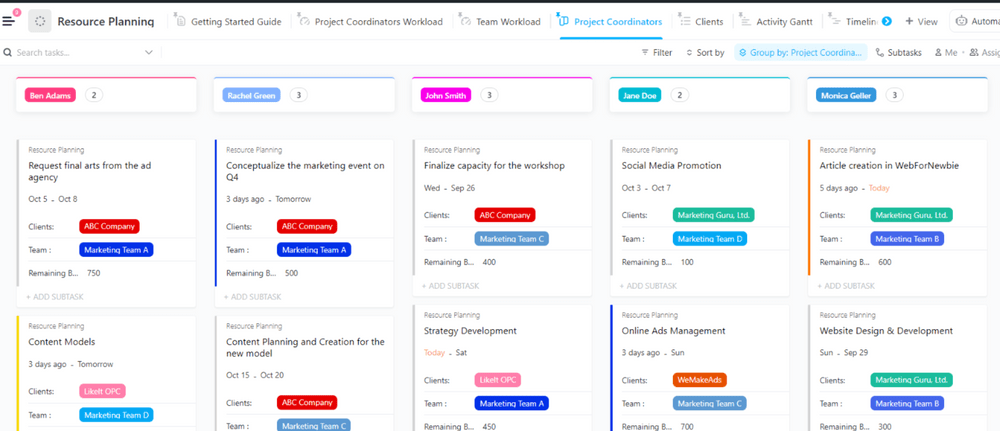
تصور المهام والموارد في مكان واحد باستخدام قالب تخطيط الموارد ClickUp قم بجدولة مواردك مع بعض الهوامش للتغييرات أو التطورات المفاجئة. لا تستخدم مواردك البشرية بنسبة 100%. الاستخدام بنسبة 75-80% يعطي مساحة للتنفس للجميع.
يحافظ الوقت الإضافي على الطاقة الإدراكية، خاصة في الأعمال الإبداعية مثل الكتابة والتصميم وتطوير البرمجيات، مما يؤدي إلى نتائج أفضل بشكل عام.
أيضًا، لا تضع جدولًا زمنيًا حتى اللحظة الأخيرة. اترك يوماً أو يومين في النهاية لتغطية أي تأخير غير متوقع. إذا تعطل موقعك الإلكتروني المطور حديثًا أو إذا كان هناك خطأ مطبعي في إعلانك الإعلاني، فإن هذا الوقت الإضافي سينقذ الموقف.
خطط حول التبعيات
لكل مشروع، مهما بدا بسيطًا، تبعيات متأصلة. خطط حول هذه التبعيات لضمان عدم إرهاق أي شخص في العمل. تأكد من عدم إثقال كاهل أعضاء الفريق بالتأخير في نهاية سير العمل.
على سبيل المثال، إذا احتاج فريق DevOps الصغير لديك إلى دفع مئات الميزات إلى الإنتاج في اليوم الأخير، فمن المحتمل أن تواجه أعطالاً تقنية وعاطفية. قم بترتيب هذه الأنشطة بعناية بدلاً من ذلك.
راقب في جميع الأوقات
راقب التقدم المحرز عن كثب, قدرة الفريق والاستخدام كل أسبوع، إن لم يكن يوميًا. تجنب التحميل الزائد أو الاستخدام الناقص لمواردك. أعد تخصيص الموارد للمهام الحرجة أو العوائق غير المتوقعة مثل حالات الطوارئ الشخصية أو المرض.
التواصل بشكل استباقي
حافظ على قنوات التواصل مفتوحة لتشجيع التعاون بين الفرق. أبقِ جميع أصحاب المصلحة على علم بالتقدم المحرز بناءً على احتياجاتهم. على سبيل المثال، سيحتاج كبير مسؤولي التكنولوجيا (CTO) إلى تحديثات أسبوعية حول تقدم المشروع بأكمله على مستوى عالٍ.
ويحتاج أعضاء الفريق الأقل من المستوى التنفيذي على مستوى المدير التنفيذي إلى تحديثات على المستوى الجزئي حول مهامهم الأولية. قم بذلك يدويًا أو قم بأتمتة التقارير على فترات منتظمة.
الوصول بالمشروع إلى نهاية ذات مغزى
- تحقق مع العميل إذا كان راضياً عن جميع جوانب المشروع
- اطلب التعليقات حول ما قمت به بشكل جيد وما يحتاج إلى تحسين
- الاحتفال بالنصر مع الفريق
- قم بإجراء استعراضات أو مراجعات للأداء لمناقشة نجاح المهمة أو المشروع كفريق واحد
- أغلق جميع المهام فيأداة إدارة المشروع والأرشفة حسب الاقتضاء
قم بتعظيم إمكانات فريقك من خلال جدولة الموارد الفعالة
لإكمال مشروع ما بنجاح، يجب أن يعرف جميع أعضاء الفريق مسؤولياتهم وأن يغطي كل منهم على الآخر عند الحاجة. من الأهمية بمكان استدعاء التبعيات والحاجة إلى إكمال مهمة ما في وقت معين. تلعب الجدولة الفعالة للموارد دورًا محوريًا في تمكين ذلك.
استفد من ميزات جدولة الموارد في ClickUp لتمكين كل مدير مشروع بأدوات لتوجيه الفريق في الاتجاه الصحيح من البداية إلى خط النهاية. وسواء كنت تقوم بتعيين الشخص المناسب للمهمة المناسبة أو اختيار مهمة ما لدفعها إلى الأمام، فإن ClickUp يمكّنك من القيام بكل ذلك. اكتشف كيفية تعظيم إمكانات فريقك من خلال اشترك مجانًا اليوم


